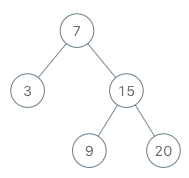Appearance
每天一道Rust-LeetCode(2019-11-14)
坚持每天一道题,刷题学习Rust.
题目描述
实现一个二叉搜索树迭代器。你将使用二叉搜索树的根节点初始化迭代器。
调用 next() 将返回二叉搜索树中的下一个最小的数。
示例: 
BSTIterator iterator = new BSTIterator(root); iterator.next(); // 返回 3 iterator.next(); // 返回 7 iterator.hasNext(); // 返回 true iterator.next(); // 返回 9 iterator.hasNext(); // 返回 true iterator.next(); // 返回 15 iterator.hasNext(); // 返回 true iterator.next(); // 返回 20 iterator.hasNext(); // 返回 false
提示:
next() 和 hasNext() 操作的时间复杂度是 O(1),并使用 O(h) 内存,其中 h 是树的高度。 你可以假设 next() 调用总是有效的,也就是说,当调用 next() 时,BST 中至少存在一个下一个最小的数。
来源:力扣(LeetCode) 链接:https://leetcode-cn.com/problems/binary-search-tree-iterator 著作权归领扣网络所有。商业转载请联系官方授权,非商业转载请注明出处。
解题思路
O(1)复杂度的思路:
- 使用map来保存数据 key到映射value以及双向链表中的元素
- get 查询,如果查询得到,从双向链表中移除并添加到尾部
- put 如果满了,则移除双向链表首部元素,同时插入map,添加到尾部 手工模拟双向链表. 双向链表操作直接借鉴自标准库
解题过程
rust
use crate::share::TreeNode;
use std::cell::RefCell;
use std::rc::Rc;
struct BSTIterator {
path: Vec<Rc<RefCell<TreeNode>>>, //保存当前路径
}
/**
* `&self` means the method takes an immutable reference.
* If you need a mutable reference, change it to `&mut self` instead.
*/
impl BSTIterator {
fn new(root: Option<Rc<RefCell<TreeNode>>>) -> Self {
let mut bst = BSTIterator { path: Vec::new() };
bst.push_left(root);
bst
}
fn push_left(&mut self, root: Option<Rc<RefCell<TreeNode>>>) {
if root.is_none() {
return;
}
let r = root.unwrap();
self.path.push(r.clone());
self.push_left(r.borrow().left.clone());
}
/** @return the next smallest number */
fn next(&mut self) -> i32 {
let l = self.path.pop().unwrap();
let val = l.borrow().val;
//左节点已经处理过了,右节点需要处理
let r = l.borrow().right.clone();
self.push_left(r);
val
}
/** @return whether we have a next smallest number */
fn has_next(&self) -> bool {
self.path.len() != 0
}
}
#[cfg(test)]
mod tests {
use super::*;
use crate::share::*;
#[test]
fn test_lru() {
let t = build_tree_ignore_parent(&vec![7, 3, 15, null, null, 9, 20]);
let mut bst = BSTIterator::new(t);
assert_eq!(bst.next(), 3);
assert_eq!(bst.has_next(), true);
assert_eq!(bst.next(), 7);
assert_eq!(bst.has_next(), true);
assert_eq!(bst.next(), 9);
assert_eq!(bst.has_next(), true);
assert_eq!(bst.next(), 15);
assert_eq!(bst.has_next(), true);
assert_eq!(bst.next(), 20);
assert_eq!(bst.has_next(), false);
}
}
一点感悟
其他
欢迎关注我的github,本项目文章所有代码都可以找到.
 Steven's Blog
Steven's Blog